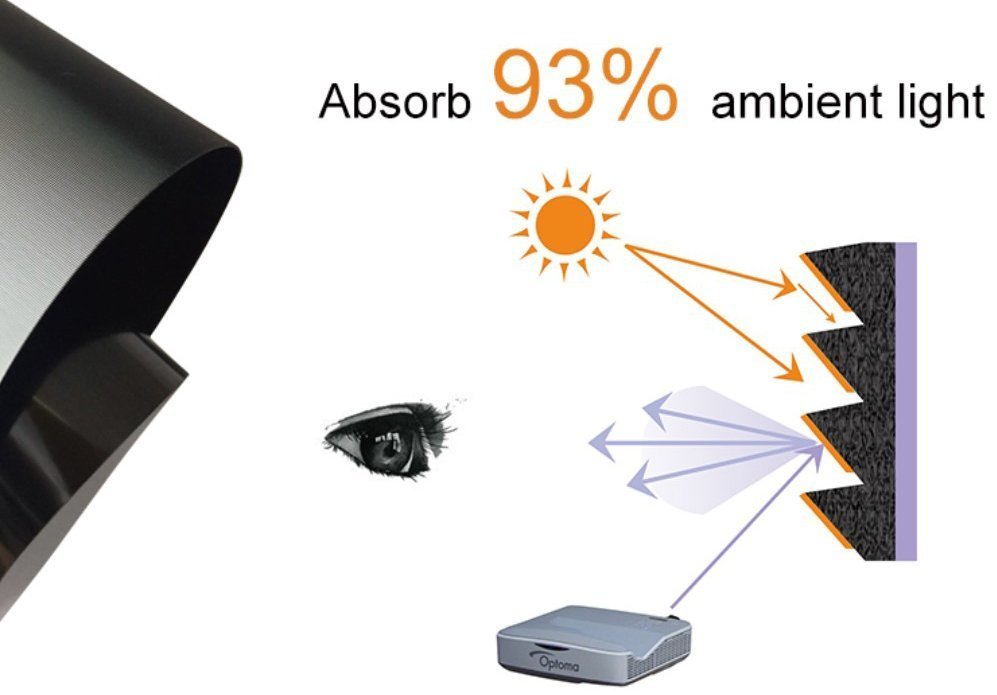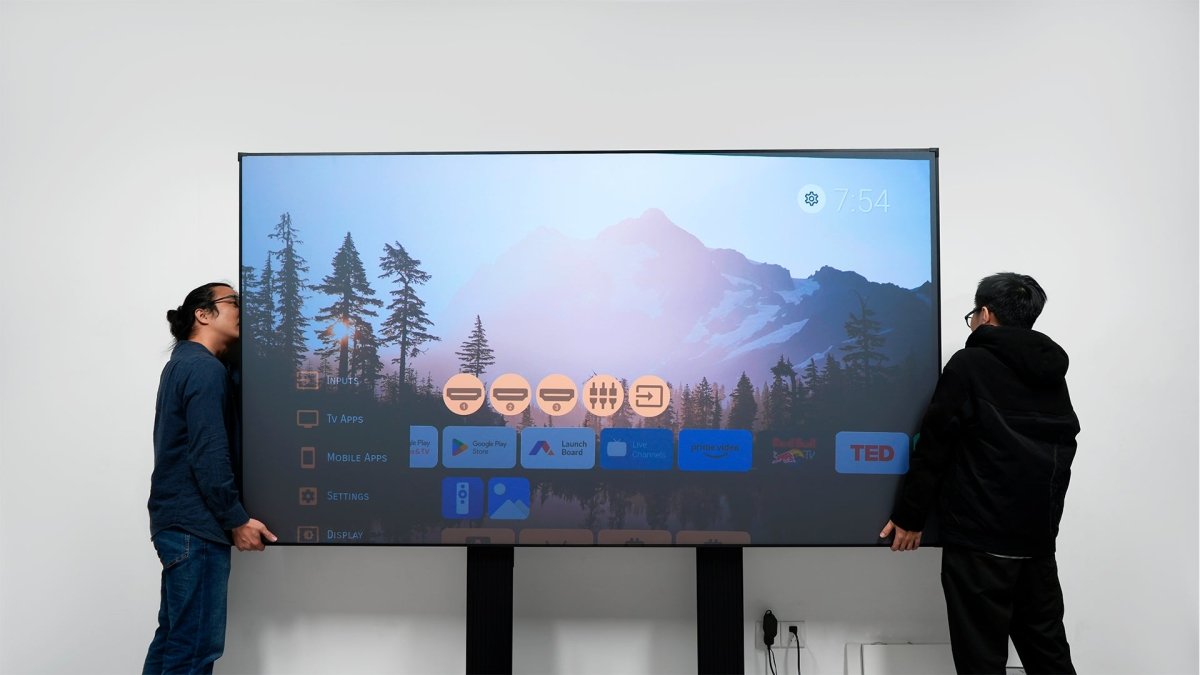Material choice for UST screens varies based on individual needs.
Generally, we recommend the Lenticular screen as the best choice for UST screen material.
What kind of screen materials are available for ultra-short-throw projectors?
As broad classification, there are two types of materials: Lenticular and Fresnel.
Ultra-short throw projectors are compatible with mostly screens and no matter what the material is. However, but the normal screens is lack of ambient light rejection capabilities.
This means that when you use an ultra-short throw projector in a glare environment, and the image sharpness may be reduced by exposure light.
Here's what it looks like when we project the ultra-short-throw projector on a white matte screen.

Here's a snapshot of my Ultra Short Throw projector coupled with the Ambient light rejecting(ALR) Lenticular Screen. As you can observe, the image maintains its vibrant colors even in well-lit conditions.
Below pictures will illustrates the distinction between a ALR screen and a normal one.

Next step, we will discuss the difference between a Lenticluar screen and a Fresnel screen.
Lenticular screen vs Fresnel screen
Quick summary:
If you're seeking superb image quality for you with your friends or familys can maintain a viewing position within 45 degrees of the central vision area, you might could consider Fresnel screen.

Fresnel screens gradually reduce brightness as the viewing angle deviates from the center, owing to their unique screen structure. This means that while sitting directly in front of the screen offers optimal viewing, viewers seated to the side will experience a slightly dimmer picture.
For scenarios where multiple viewers need to enjoy consistent picture quality, Lenticular material will be a better option. It offers wideer viewing angle and up to 170 degrees.
However, the Lenticular material is not as effective as the Fresenl material from a central visual point of view.


Why are there exist differences between those two kinds? Because their screen structures are different.
Lenticular screen structure
This type of screen has a sawtooth-like structure that the screen surface coated with black layer and white slopes serving as reflective layers at the same time.
The black coating absorbs light from above to preventing light reflection and resulting in a clearer projected image.

Fresnel screen structure
This light-resistant property of Fresnel screens enhances their ability to render images with superior clarity and brightness. In contrast, lenticular screens lack the ability to block light from the sides, making them slightly less resistant to ambient light.
Fresnel's gain also be higher than lenticular screens.
Viewing Angle
What is a viewing angle?
Put simply, it's the angle at which a viewer can see all content displayed on the screen clearly.
For traditional televisions, viewing angle is typically 180 degrees.
Lenticular screens offer a viewing angle of 160 to 170 degrees. However, while mostly suppliers announced that Fresnel screens have a viewing angle of 90 to 100 degrees, But if you have particularly requirement about image quality, the practical viewing angle limitation for Fresnel screens is around 60 degrees.
As shown in below videos, we'll compare the difference of Lenticular and Fresnel screens at 0 degrees, 45 degrees, and nearly 90 degrees.
Please be aware that the overexposure of the Fresnel screen at 0 degrees is not accurate because of the camera parameters. In real-life viewing by your eyes, it will not be like that.
This means that if you stand in the center area of the Fresnel screen, you'll got excellent visual experience totally.
However, when you stand on either side of the screen, at angles of 30 degrees or 60 degrees from the center, you'll notice that as your angle increases, the brightness of the picture gradually is slowly decreases.
The lenticular screen, on the other hand, doesn't have this limitation. It has a viewing angle of 170 degrees, meaning that if you're planning to invite your friends over to your living room to watch the game, you'll both be able to enjoy the same vibrant picture under high-quality .
If hosting parties isn't the normalcy situation and you prefer cozy movie nights with just a couple of friends that all seated within a 45-degree angle of the screen's centerline, then choose Fresnel screen might be the ideal choice for you.
Screen Type
Lenticular screens are made of flexible material, allowing them to be rolled or curved, whereas Fresnel screens are rigid and cannot be bent.
This flexibility enables lenticular screens to be used in various configurations such as drop-down, floor rising, or fixed frame, while Fresnel screens are typically limited to fixed frame installations.
There are also risks you may need to take by choosing Fresnel
Hotspots:
What are hotspots?
A hotspot refers to the uneven brightness across the screen, where the center appears brighter than the edges.
To illustrate, imagine shining a flashlight against a wall. You'll notice a brighter center with gradually diminishing brightness towards the edges, resembling what we refer to as a hotspot.
This phenomenon may result in whites and colors appearing significantly brighter in the center of the screen compared to the top and sides.
Ceilings reflect light:
If your home own low ceilings, choosing a Fresnel screen may also run the risk of reflected light from the ceiling.
How to avoid the aforementioned issues:
Usually the above problem occurs because of the less favorable raw materials of Fresnel.
We highly recommend opting for a premium Fresnel screen.
Our Nothing Projector Fresnel screens are crafted from top-tier fabrics in the industry, effectively mitigating the aforementioned issues.





1 comment
Dimitri
Salve,il kit Proiettore Formovie Theater 4K UHD Ultra Short Throw 2800ANSI Smart Laser TV con schermo NT è quel schermo che respinge da 3 lati la luce? Pet Crystal?
Leave a comment
All comments are moderated before being published.
This site is protected by reCAPTCHA and the Google Privacy Policy and Terms of Service apply.